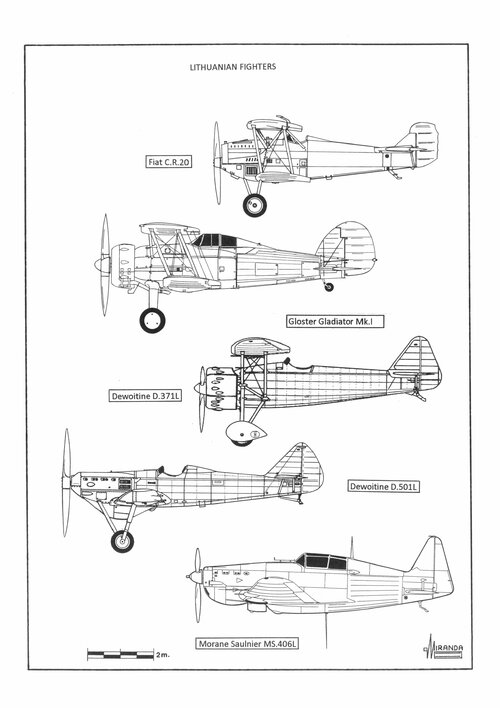From: “Enemy at the Gates: Panic Fighters of the Second World War”
Lithuania
To protect their independence, obtained on 16 February 1918, this small Baltic country was forced to create an Air Force (Karo Aviacija) that was formed by twelve Ansaldo SVA 10 reconnaissance airplanes and twelve fighters of the Martinsyde F.4 and Letov S.20L types.Lithuania
In the mid-1920s these aircraft were enough to deter the Soviets, whose VVS strength was of 340 aircraft only. But in 1928, the potential aggressor started a series of Five Years Plans for the massive production of weapons. In 1929 the VVS had already 1,280 airplanes, in 1933 already had 3,150 and 8,140 in 1937. Although they lacked the quality of western designs, their large number was worrisome for countries bordering the U.S.S.R. and this was the cause of the beginning of an arms race.
Following the entry into service of the Polikarpov I-3 (279 kph) in 1929, Lithuania ordered fifteen Fiat C.R. 20 (270 kph) that were superior to the Russian airplane in dogfight and climb. From mid-1934, the VVS based its strategy in the use of large mixed formations of biplanes Polikarpov I-15 (286 kph) and monoplanes Polikarpov I-16 Type 4 (362 kph) armed with four 7.62 mm machine guns.
To counter the new threat, Lithuania ordered twenty Dewoitine D.371L (359 kph) monoplane fighters armed with four 7.7 mm machine guns. By the end of 1936 the Polikarpov I-16 Type 5 (445 kph) entered service with enhanced armament and Lithuania decided to change their D.371 by thirteen Dewoitine D.501L armed with a 20 mm H.S. 9 cannon and two 7.7 mm machine guns.
In 1937 the Polikarpov I-152 (397 kph) fighter biplane appeared, designed to replace the I-15. Lithuania ordered fourteen biplanes Gloster Gladiator Mk.I (407 kph) superior in manoeuvrability and climb. In 1939, the Polikarpov I-16 Type 17 (425 kph) armed with 20 mm cannons came into service and Lithuania ordered thirteen Morane-Saulnier M.S. 406L monoplane fighters armed with a 20 mm H.S. 404 cannon and two 7.7 mm machine guns. Unfortunately, the French needed these aircraft to defend themselves against the Luftwaffe and decided not to honour the agreement.
Between 1925 and 1939 the Lithuanians created a small aeronautical industry capable of supplying ANBO-III trainers and reconnaissance airplanes ANBO-41 to the Karo Aviacija. They also built the prototype of the ANBO-VIII, a dive bomber that flew for the first time on 5 September 1939, but they lacked the technology required for the construction of advanced fighters. When the Red Army occupied Lithuania on 15 June 1940, the Karo Aviacija only had fourteen Ansaldo A.120, seven Fiat C.R. 20, fourteen ANBO-41, one ANBO-VIII, thirteen Dewoitine D.501L, fourteen Gladiator Mk.I and three interned aircraft: one Messerschmitt Bf 109, one Henschel Hs 126 and one P.Z.L. P.37
Bibliography
Books
Humberstone, R., Lithuanian Air Force 1918-1940, Blue Rider Publishing, 1996.
Marchand, P., Dewoitine D.500, D.510, Les Ailes de Gloire Nº3, Editions d’Along, 2004.
Comas, M., Le Morane Saulnier M.S.406, Histoire de l’Aviation Nº5, Lela Presse 1998.
Publications
Jasiunas, E., “Lithuanian Aviation 1918-1940”, SAFO nº39, July 1986.
Dulaitis, D., “Color schemes and insignia of Lithuanian aircraft at the beginning of the WWII” SAFO vol.14, nº3 and 4, October 1990.
Passingham, M., “Les Inconnus de la Baltique, l’Industrie Aéronautique Lituanienne”, le Fanatique de l’Aviation Nº 271.
Bezouska, P., “Lithuanian Adenda”, Air Enthusiast/Thirty.

